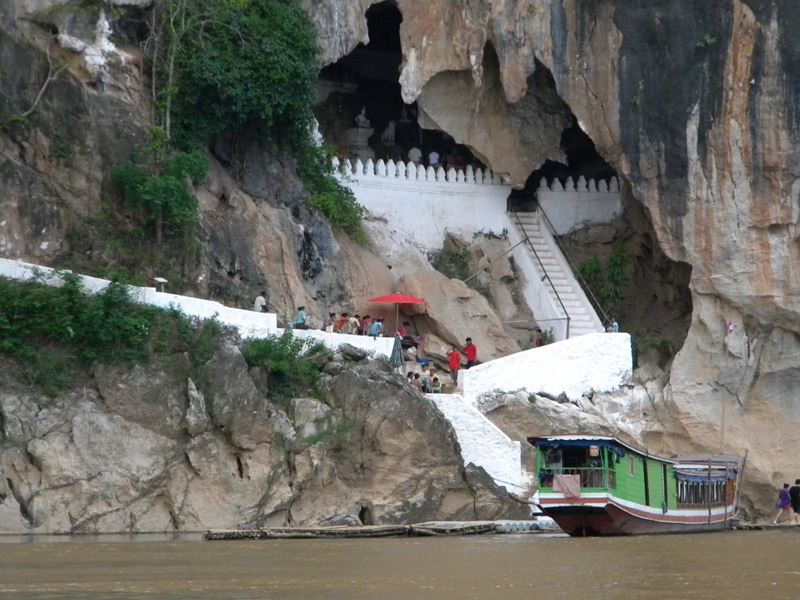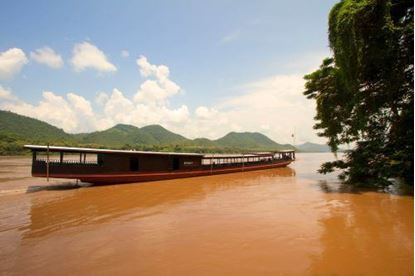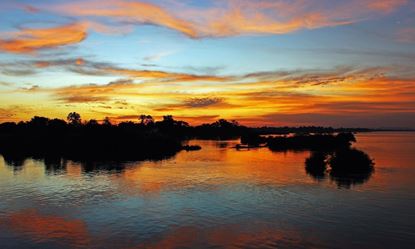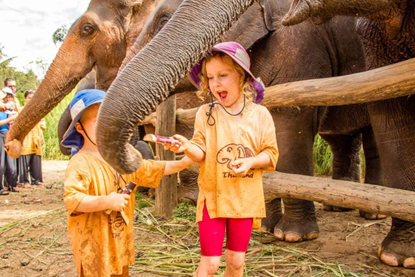- Home
- Luang Prabang
- Wat Long Khoun Temple
Wat Long Khoun Temple
Wat Long Khoun, the Monastery of the Happy (or Blessed) Song would be a special point in your journey to Luang Prabang, as this place was a very important temple during the Royal days of the past.
Founded in the 18th century and is opposite Wat Xieng Thong Temple, across a river, making it easy to find and explore.
Wat Long Khoun played a very important role for the Royal families of Luang Prabang because, since its inception, it has been considered as a retreat center for spiritual revitalization. As a result, the Kings have had to spend three days there to attend the bathing and meditation ceremony before returning to the Wat Xieng Thong temple for their coronation.
This monastery was abandoned and broken down at the fall of the monarchy. In the mid-1990s, it was restored by the French School of the Far East and the Department of Museums and Archeology of Laos.
Wat Long Khoun represents the local architecture of Luang Prabang with two simple parts, front and back; however, the front part was enlarged in 1937 by King Sisavonvang. It has beautiful gilded columns and a wooden pediment wonderfully carved with floral spirals.
The back part is the unique ordination hall, and has beautiful interior wall paintings that describe the life of Buddha. Unfortunately some are now in poor condition due to moisture and years abandonment after the fall of the monarchy but the paintings colors still remain.
This temple has six houses for monks, and there is also a small, long windowless structure near the ordination hall which was used as a meditation room for Kings, their male relatives and male friends.
Nearby Wat Long Khoun is a cave temple - Wat Xieng Maen which guards ancient and damaged Buddha images. It normally opens only during the Laos New Year.
As for Wat Long Khoun, it is open every day between 8 am and 5 pm. The ticket price is 10000 LAK (approximately US $ 1,25) and being it a sacred place, it is necessary to remove your shoes and sunglasses before entering
-
exotic laos travel
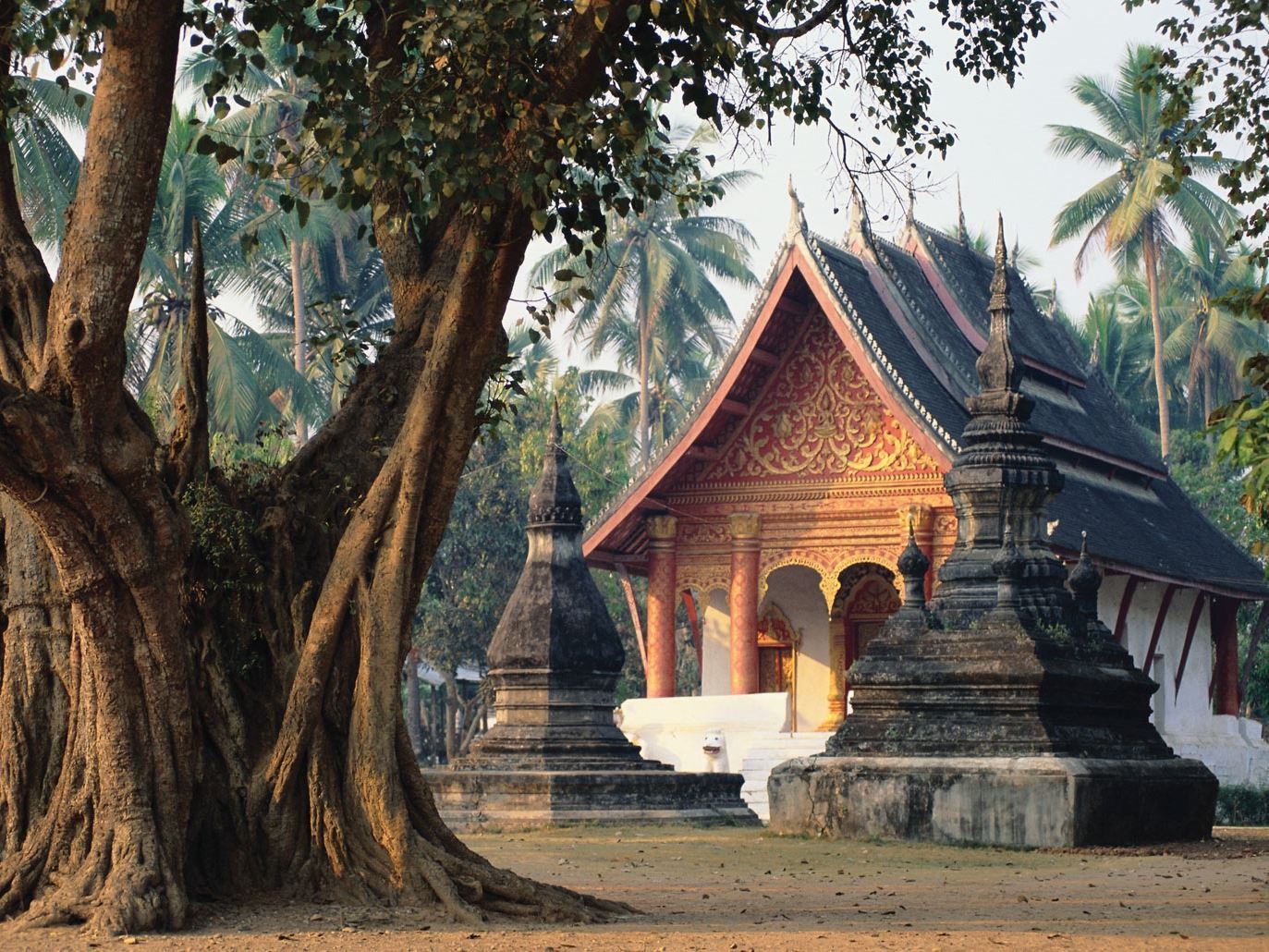
Related Attractions
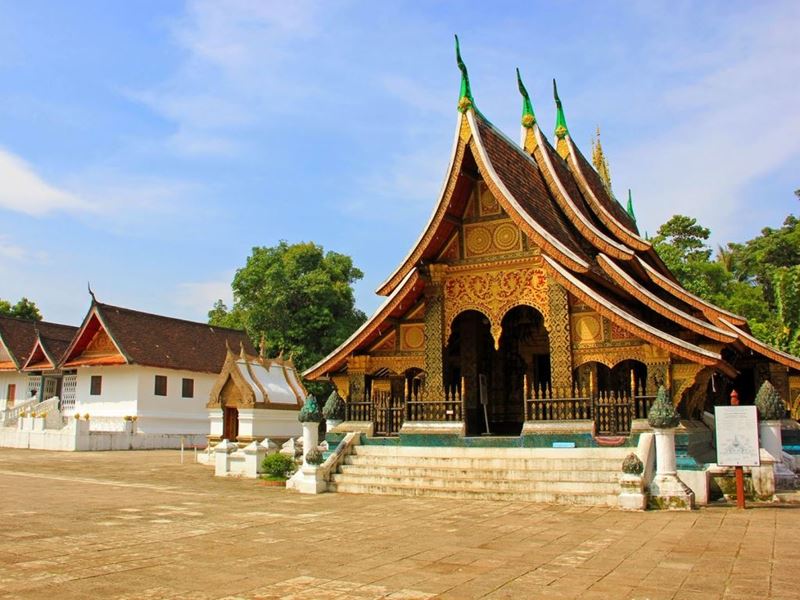
Wat Xieng Thong Temple
<p style="text-align: justify;"><strong>Wat Xieng Thong</strong> is a Laotian Buddhist temple in the ancient capital LuangPrabang and was built by King Setthathirat in 1560. It plays an important role in the psychic life of Laotians. Wat Xieng Thong means the "monastery of the Golden City", one of the higher symbols of Buddhism in Laos.</p> <p style="text-align: justify;">This place is built in a particular architectural style of Laos, with a curved roof that nearly touches the ground. There are also a number of smaller temples, built in the same style.</p> <p style="text-align: justify;">Wat Xieng Thong keeps a famous reclining Buddha statue, once in the Paris museum.</p> <p style="text-align: justify;">Crossing many historical events, this temple was almost destroyed. In 1960, it was restored on a large scale, and now is like days of old.</p> <p style="text-align: justify;">After the fall of Monarchy in Laos, Wat Xieng Thong was longer the royal temple, but is still very important for Laotians.</p> <p style="text-align: justify;">From its entrance tourists, can easily see a small temple on the left and a royal carriage inside. This carriage was used by King Sisavong. It is very grandiose and elegant.</p> <p style="text-align: justify;">Talented artists have made the mural paintings that tell about mysterious stories of Buddhism.</p> <p style="text-align: justify;">During the main festivals, Wat Xieng Thong becomes really lively and crowded, especially when there are many people visiting the Golden Buddha statue and participating in the Buddha Bathing Ceremony .</p> <p style="text-align: justify;">Because of the beautiful architecture and its original festivals, Wat Xieng Thong has become a celebrated temple that fascinates most visitors.</p>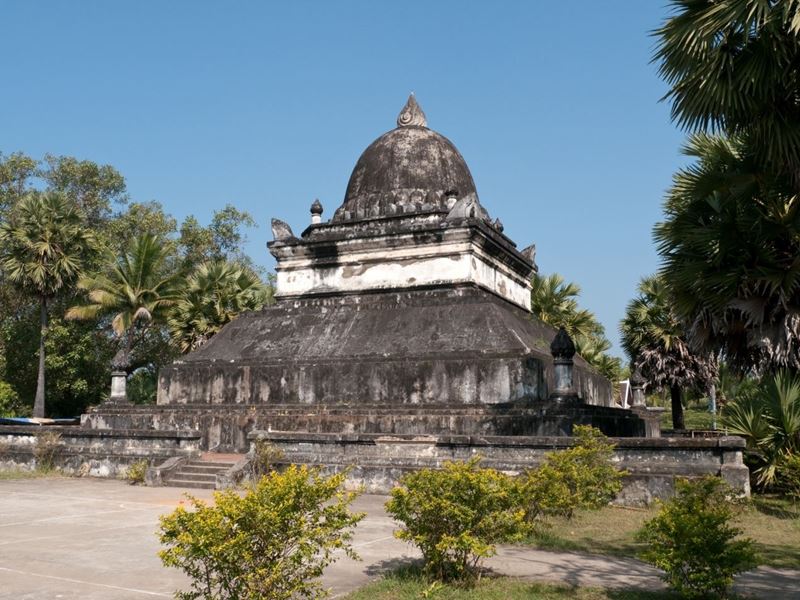
Wat Visoun Temple
<p style="text-align: justify;"><strong>Wat Wisunarat Temple</strong> is more commonly known as <strong>Wat Visoun</strong> and is one of the oldest temples of Luang Prabang and has been recognised by UNESCO and is on the list of World Cultural Heritage places. It was originally built in 1513 then restored and rebuilt between 1889 and 1896. You will find it on the road that bears its name in the city centre. The temple contains a green herbal garden, amongst other things, but in front of the large grounds there is a tower named Tha Pathum which is 35mts high! The tower was erected between1503 and 1505 at the bequest of King Wisunarat’s wife.</p> <p style="text-align: justify;">It has been built with simple architecture, but its metallic roofs have much decoration. With its original wooden windows, the main temple is made of bricks and a ticket must be obtained before entering the site. Tucked behind the temple is the housing for the (mostly young) monks who live and study in (Wat Wisunarat) Wat Visoun, and because they are young and natural, they love to broaden their horizons and talk about their daily life: we can assist with that uf you like.</p>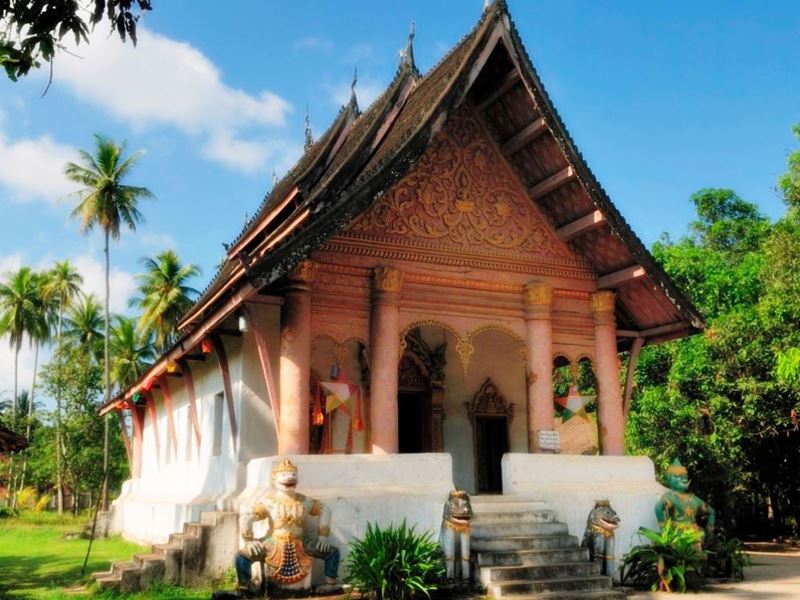
Wat Aham Temple
<p style="text-align: justify;"><strong>Wat Aham</strong> is located next to Wat Wisunarat, on the Phomathat Road, just south of <strong>Phousi Mountain</strong> in Luang Prabang. Wat Aham in Laotian means "Monastery of the Open Heart". The temple consists of an ordination hall and two ancient stupas. Its construction dates back to 1818, on the site of an even more ancient temple dating back to 1527. It is a very calm place, except when children from the nearby school go through the grounds!</p> <p style="text-align: justify;">Between Wat Aham and the street are two large and very old banyan trees, said to protect the guardian spirits of Luang Prabang City (Devata Luang).</p> <p style="text-align: justify;">From the outside, Wat Aham is the shape of a tent standing on a white and rectangular base that seems to be made of marble with a pointed, tiled and gigantic three-tiered roof. Around its flanks, at the entrance, are guardian tigers and next to them, Hanuman and Ravana, two characters come from Phra Lak and Phra Ram.</p> <p style="text-align: justify;">Locals believe that around 14th century on the site where Wat Aham is located, a sanctuary was built for the Guardian Spirits, namely Pu-No and Na No. Inside the temple the walls, pillars, main doors and lattice windows are mainly painted red and golden. There are many other paintings and murals, which come from a talented painter, most of these paintings express famous scenes, especially describing hell.</p> <p style="text-align: justify;">The sanctuaries were ruined two centuries later, during the reign of King Phothisarath who was a Buddhist devotee who ruled to end animism and spirit worshipping. So he demolished the sanctuaries and then established a Buddhist temple on the place of Wat Aham.</p> <p style="text-align: justify;">You can go here by foot, by tuk-tuk or by bike. A ‘walk’ by tuk-tuk could cost between about US $1 and US $2, depending on the distance, and your negotiation skills. You must also buy tickets before entering. The temple, it opens daily from 8am to 5pm.</p> <p style="text-align: justify;">Today, Wat Aham is no longer a religious ceremonies center of local people, but still always a well-known tourist site that houses numerous monks.</p>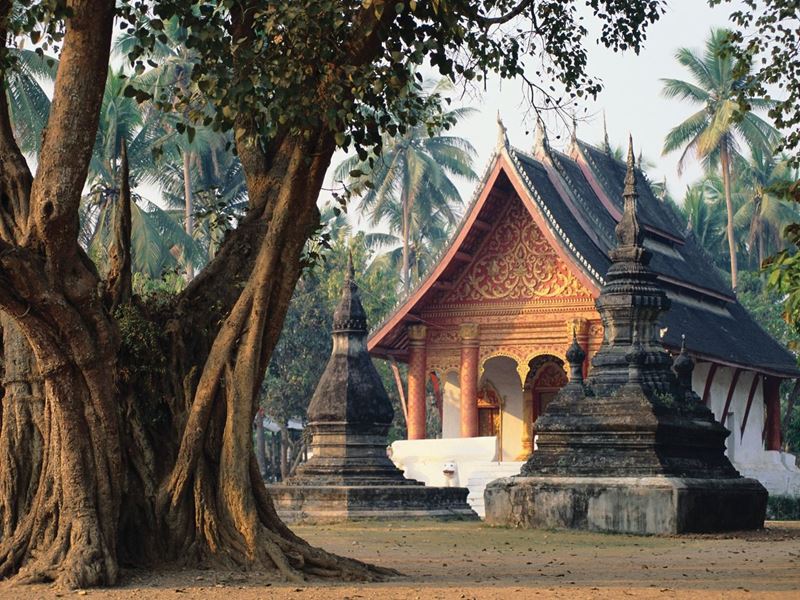
Wat Long Khoun Temple
<p style="text-align: justify;"><span><strong>Wat Long Khoun</strong>, the Monastery of the Happy (or Blessed) Song would be a special point in your journey to Luang Prabang, as this place was a very important temple during the Royal days of the past.</span></p> <p style="text-align: justify;"><span>Founded in the 18th century and is opposite <strong>Wat Xieng Thong Temple</strong>, across a river, making it easy to find and explore.</span></p> <p style="text-align: justify;"><span>Wat Long Khoun played a very important role for the Royal families of Luang Prabang because, since its inception, it has been considered as a retreat center for spiritual revitalization. As a result, the Kings have had to spend three days there to attend the bathing and meditation ceremony before returning to the Wat Xieng Thong temple for their coronation.</span></p> <p style="text-align: justify;"><span>This monastery was abandoned and broken down at the fall of the monarchy. In the mid-1990s, it was restored by the French School of the Far East and the Department of Museums and Archeology of Laos.</span></p> <p style="text-align: justify;"><span> </span>Wat Long Khoun represents the local architecture of Luang Prabang with two simple parts, front and back; however, the front part was enlarged in 1937 by King Sisavonvang. It has beautiful gilded columns and a wooden pediment wonderfully carved with floral spirals.</p> <p style="text-align: justify;"><span>The back part is the unique ordination hall, and has beautiful interior wall paintings that describe the life of Buddha. Unfortunately some are now in poor condition due to moisture and years abandonment after the fall of the monarchy but the paintings colors still remain.</span></p> <p style="text-align: justify;">This temple has six houses for monks, and there is also a small, long windowless structure near the ordination hall which was used as a meditation room for Kings, their male relatives and male friends.</p> <p style="text-align: justify;"><span>Nearby Wat Long Khoun is a cave temple - Wat Xieng Maen which guards ancient and damaged Buddha images. It normally opens only during the Laos New Year.</span></p> <p style="text-align: justify;">As for Wat Long Khoun, it is open every day between 8 am and 5 pm. The ticket price is 10000 LAK (approximately US $ 1,25) and being it a sacred place, it is necessary to remove your shoes and sunglasses before entering</p>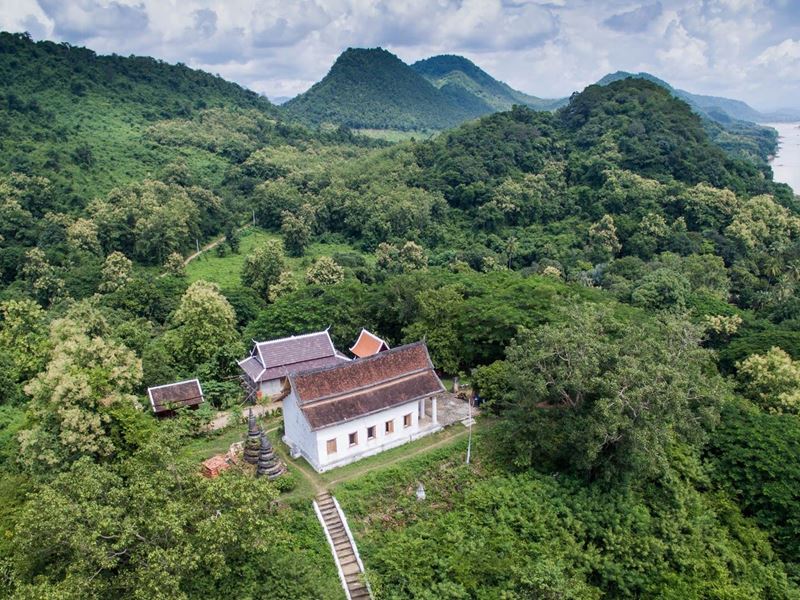
Wat Chomphet Temple
<p style="text-align: justify;">If you would like to contemplate the panorama of Luang Prabang city, <strong>Wat Chomphet</strong> would be a perfect choice during your visit to the temples of Luang Prabang.</p> <p style="text-align: justify;">Located on the other side of the Mekong River, and in the north of Ban Xieng Mene, it was built in 1888 on a quite flat hilltop; this temple offers a magnificent panoramic view of the Mekong River and Luang Prabang.</p> <p style="text-align: justify;">There are approximately 100 steep steps leading to <strong>Wat Chomphet</strong>. This temple is really charming and is surrounded by many trees. Although this temple is a bit small and run down, it is being extensively renovated. It has a two - tier roof without tile, and the exterior details are very simple, with the wall painted in white. Inside, the ceiling has been decorated with many golden stenciled images.</p> <p style="text-align: justify;">This temple opens daily between 8am and 5pm. The entrance fee is 10000 LAK (approximately US $ 1), with entrance fees helping towards the renovation. It should be noted that walking along the trail is free but if you want to see the temple, you have to pay an entrance fee. It is a lovely walk between <strong>Wat Chomphet</strong> and the other temples and we are sure it will please you very much.</p> <p style="text-align: justify;">Finally, as it is a sacred place, men and women should dress politely.</p>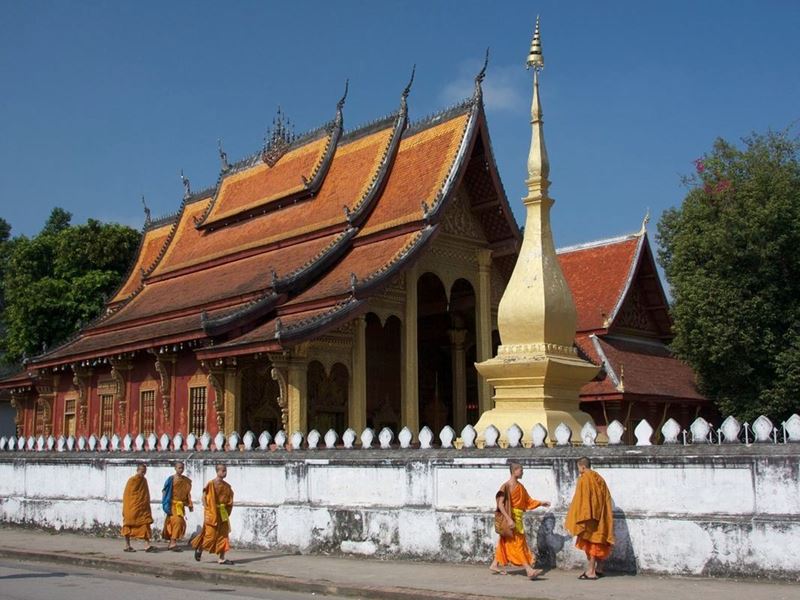
Wat Sene Temple
<p style="text-align: justify;"><strong>Wat Sene Souk Haram (Wat Sene)</strong> in Laotian means the <strong>"temple of a 100,000 treasures".</strong> Indeed, it is one of the most beautiful temples of <strong>Luang Prabang</strong>, and should be on the list of places to visit when you tour Luang Prabang.</p> <p style="text-align: justify;">Founded in 1718 by Tia Tiao, under the reign of King Kitsarath with about 100,000 stones from the Mekong River, the temple is directly on the main road. It consists of an ordination hall, a stupa, a pirogue shelter (there are two very beautiful pirogues, used during the pirogue races in August or September), a drum tower and several koutis.</p> <p style="text-align: justify;">Wat Sene was restored in the 1930s and again in 1957 to celebrate the 2500th anniversary of Buddha. Now the temple is known as one of the best places to visit in Luang Prabang.</p> <p style="text-align: justify;">The temple is covered with yellow and red tiles; it is the first one applying this style of color in Luang Prabang (now you find the same at Wat Nong Sikhounmuang). This place houses the Patriarch of the monks of the city.</p> <p style="text-align: justify;">From the outside, <strong>Wat Sene</strong> seems like a <strong>splendid palace without a door but with a three-tier roof.</strong> It has a thickly gilded facade and a wooden pediment complexly carved with wondrous floral spirals. Next to its flanks, at the entrance, are two gilded guardian tigers.</p> <p style="text-align: justify;">Wat Sene is truly a masterpiece of Buddhist architecture that you should not miss during your time in Laos.</p>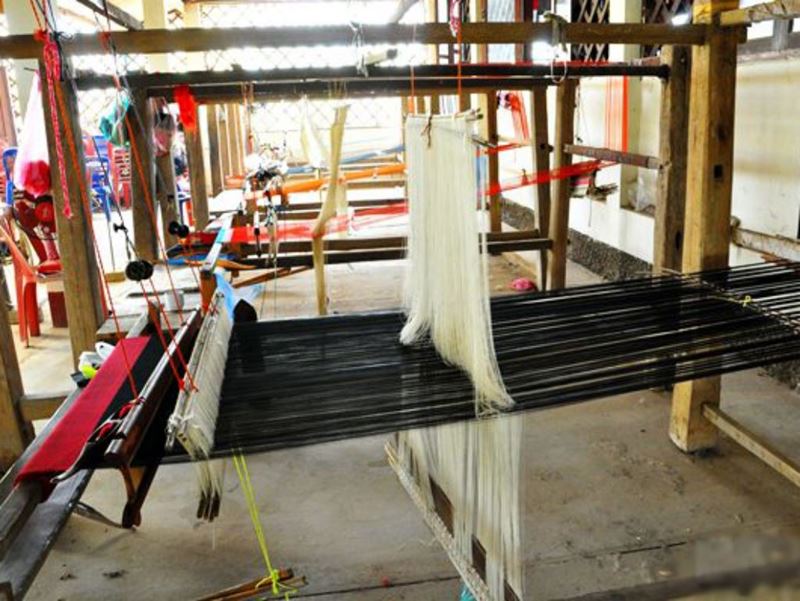
Ban Phanom Village
<p style="text-align: justify;"><strong>Luang Prabang</strong> is not only the city of “a thousand temples” but also has “a thousand traditional craft villages”. The <strong>Ban Phanom village</strong> is certainly one of the districts finest, and one of the places to visit during your tour of Laos.</p> <p style="text-align: justify;">Located on the bank of the Nam Khan River, about 2kms from the Phon Phao temple, in the north of Luang Prabang, Ban Phanom is a village steeped in traditional textile making. As a result, most villagers live thanks to the woven products sold at the night market in Luang Prabang.</p> <p style="text-align: justify;">This village was once one of the biggest suppliers of textiles to the Royal family. It is very rich in culture, history and weaving experience that you can find in very few villages of Laos, for example: Sam Neua, Luang Namtha, etc.</p> <p style="text-align: justify;">The weavers of the village today still use the same models and techniques as in the past. Most of the textile production applies a technique that couples silk and cotton. That means the weft is made of cotton yarns, while the patterns are woven from the silk. Many families in the village work in their small workshops as a cooperative that provides several manufacturers. The price of textile products is fairly affordable and always negotiable.</p> <p style="text-align: justify;">Besides buying souvenirs and learning about the culture of the village, you can also take a bicycle tour and make further discoveries further afield.</p> <p style="text-align: justify;">Ban Phanom receives many tourists every year thanks to its cultural and traditional beauty. If you want to <strong>see local people make textile products</strong> and buy them on the spot, it is absolutely necessary to go there. It will take about 10 minutes in tuk-tuk from the center of Luang Prabang; otherwise you can go there by bike but please note that it is quite an undulating course to travel.</p> <p style="text-align: justify;">After the visit of Ban Phanom has ended, you can also visit the nearby <strong>Phon Phao village</strong>, or further, see Henri Mouhot's grave and the elephant camps.</p>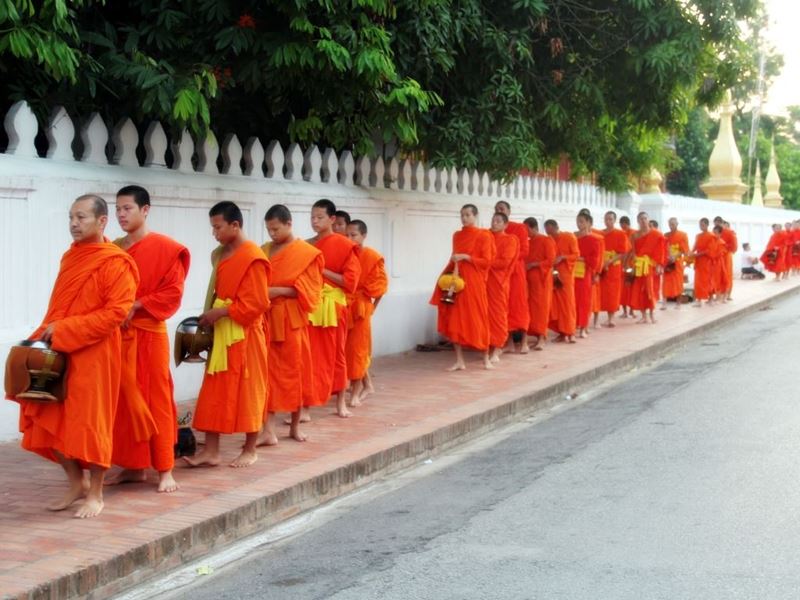
Tak Bat (Almsgiving) in Luang Prabang
<p style="text-align: justify;">If you are travelling to <strong>Luang Prabang</strong> then attending the “<strong>collection of alms</strong>” is a must do exercise. The ceremony is unique to Laos, especially in Luang Prabang, and cannot be found anywhere else in the world.</p> <p style="text-align: justify;">Known as “<strong>Tak Bat</strong>” to the locals, it has long fascinated many tourists, because of its originality. It is based on the moral of Theravada Buddhism, which is practiced in Laos.</p> <p style="text-align: justify;">At approximately 6:00am each morning the monks assemble in the great temples with their “begging bowls”, and then led by the experienced senior monks, they proceed in single file along their designated routes begging for food, for their daily sustenance.</p> <p style="text-align: justify;">Locals present foods; like sticky rice, fruit, cakes, lollies and water etc.</p> <p style="text-align: justify;">The monks, resplendent in their colourful costumes, walk bare footed through the streets where people with food assemble. Upon arrival of the monks the devotees place their offerings into the bowls and receive a prayer and a blessing as a reward.</p> <p style="text-align: justify;">When the monks have finished their journey, they all return to their temples for breakfast. Normally they only eat one meal before sunset and they do not eat by themselves, but share the food with the poor, other monks and animals.</p> <p style="text-align: justify;">The walking monks do not discriminate between rich and poor, nor do they discriminate over the offerings.</p> <p style="text-align: justify;">There are a number of things to remember if you attend the ceremony:</p> <p style="text-align: justify;">• Do not offer uncooked food or money to the monks.</p> <p style="text-align: justify;">• Do not speak loudly or point your fingers at the monks.</p> <p style="text-align: justify;">• Never approach very close to the monks, or use a device with a flash.</p> <p style="text-align: justify;">• Always dress politely and modestly</p> <p style="text-align: justify;">• You should remove your shoes and kneel down in front of the monks.</p>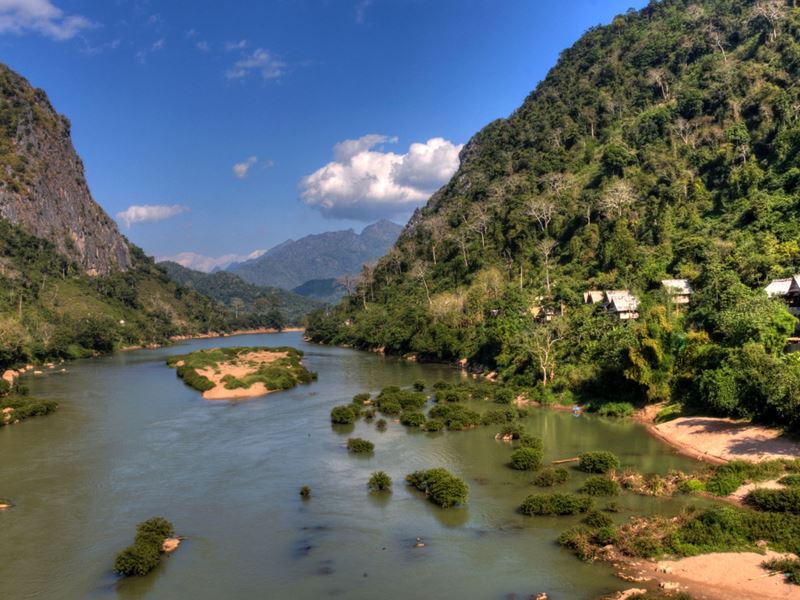
Nong Khiaw
<p style="text-align: justify;"><strong>Nong Khiaw</strong> is small village, which is located about 150 km north of Luang Prabang and on the banks of the Nam Ou River because it offers picturesque landscapes and the slow rhythm of life. Indeed, the Laotians often say: "You want to leave the sounds of the city and enjoy the sweet flavour of living in Laos? Then come to Nong Khiaw.</p> <p style="text-align: justify;">Nong Khiaw also pronounced Nong Kiau, or Nong Kiew is on Route 1 - towards Sam Neua and Vietnam. What makes this village more appreciated by tourists are the decent accommodations, inexpensive, a few nice retaurants, and especially the warm locals. In addition, Nong Khiaw is also known as a beautiful privileged stage after a long itinerant trip across the country, especially the beautiful Muong Ngoi village located about 1h by boat from Nong Khiaw.</p> <p style="text-align: justify;">Almost every 300 meters of Nong Khiaw shoreline are surrounded by lush green vegetation, steep cliffs that allow you to enjoy long walks, and interesting expeditions.</p> <p style="text-align: justify;">Nong Khiaw is divided into two parts by a fairly solid bridge. The majority of the residents are on the west side, however the guest houses on the east side.</p> <p style="text-align: justify;">As this village is small and far from the Luang Prabang center, one can discover there the overflowing nature (sugar loaves, rice fields) and the authentic culture that time has not influenced. In the past, this place was poor and short of infrastructure but today local people have set up an automated teller machine (ATM) in Nong Khiaw. In addition, tourists may have many more options of pasta in local restaurants and a 24 hours a day electricity service.</p> <p style="text-align: justify;">Besides mountains and forests, it is possible to explore <strong>beautiful caves</strong> (<strong>Phatok, Pha Kuang</strong>, etc.), dirt roads, especially the 100 waterfalls. (These are not really 100 waterfalls, but rather the continuous cascades.)</p> <p style="text-align: justify;">As for the caves, you can go there by taking a walk of about 45 minutes on foot, otherwise by bike. Particularly, the inhabitants have already used them as domiciles in times of war.</p> <p style="text-align: justify;">By doing a tour outside this village, you can meet the Khmu or Hmong villages. Most of them still maintain their own customs, traditional costumes and languages. If you intend to make a circuit in Luang Prabang, please consult the Traditional Arts and Ethnology Centre (TAEC) before reaching Nong Khiaw for more information on this subject.</p> <p style="text-align: justify;">Nong Khiaw is undoubtedly a quiet and ideal destination for people who want to admire the natural and cultural beauty while enjoying a pleasant moment on the banks of the Nam Ou River with a book and a glass of refreshing beer. </p> <p style="text-align: justify;">Regarding the modes of transport, there are buses from Luang Prabang to Nong Khiaw (about 4 hours), some other buses like the tourist bus from South Station, two local buses from North Station, buses from Udomxay, whose rates are based on each journey.</p> <p style="text-align: justify;">There was once a boat service operating between Nong Khiaw and Luang Prabang but now, it stopped, due to the construction of a dam. This allows buses and cars to cross this dam to go directly to Nong Khiaw.</p> <p style="text-align: justify;">You should come there in the dry season or at the beginning of the rainy season to let a little time for the roads in Nong Khiaw rebuilding after the rain (in the rainy season). </p> <p style="text-align: justify;">You will find below a list of interesting things to do in Nong Khiaw:</p> <p style="text-align: justify;">• Take a walk through the village with a wonderful view of the Nam Ou River (there is a small temple in the city center).</p> <p style="text-align: justify;">• Walk or pedal the bike on the dirt road behind the Riverside station for picturesque scenery and nature.</p> <p style="text-align: justify;">• Rent a mountain bike to visit the Khmu or Hmong villages since there is a lot of ‘going up and down’.</p> <p style="text-align: justify;">• Experience a Hammam or massage at Sabai Sabai.</p>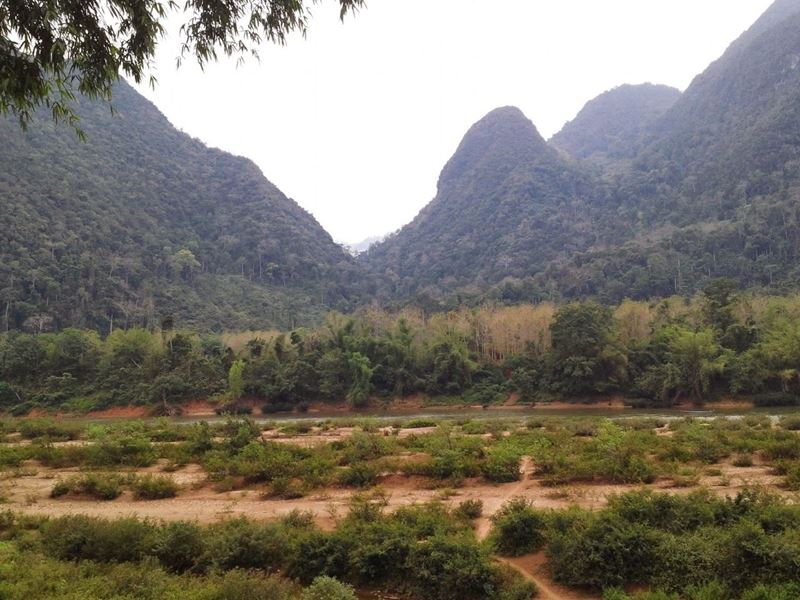
Muang Ngoi
<p style="text-align: justify;">If you enjoy a stroll while admiring all the pretty villages, the sweet Nam Ou river and the green range of mountains, <strong>Muang Ngoi Neua</strong> would surely satisfy you. This small village nestled about 170 km northeast of the Luang Prabang City. This place is an ideal stopover for tourists looking for authenticity and calm. Muang Ngoi is divided into two parts: on one side closest to the Nam Ou River, guest houses, restaurants and places for tourists ; On the other side, the homes (often pretty chalets on stilts) of the villagers with trees and mountains. This village has a pretty lively river quay.</p> <p style="text-align: justify;">Indeed, although in recent years, Muang Ngoi looks more touristic with many more restaurants, hotels and cafes than before, its atmosphere still remains peaceful even from time to time, you will find yourself in an ancient village far from the modern life with the tumultuous cock-crow at the banks of the river, the sound of the children playing and with the cows bathing.</p> <p style="text-align: justify;">Sailing along the Nam Ou while contemplating the rustic aesthetics of the village and the undulating mountains in a continuous way is a pleasure much appreciated by travelers coming to Muang Ngoi. Around this town there are some other ethnic villages such as Bana, Huay Bo, and Huay Sen. You can walk about 30 minutes from Bana to visit Tham Kang Cave,but you would need a bike or a scooter to discover all the surroundings of Muang Ngoi.</p> <p style="text-align: justify;">The only way to get to this village is to take the boat from Nong Khiaw - the Muang Ngoi’s elder sister or from Muang Khua (in Phongsali province). Then you will be attacked by all the guest houses of the village which are generally rooms in the form of bungalow with a view on the Nam Ou river.</p> <p style="text-align: justify;">As for the dishes at Muang Ngoi, some restaurants offer local cuisines, others offer buffets, waffles, cakes, sandwiches, fruits...</p>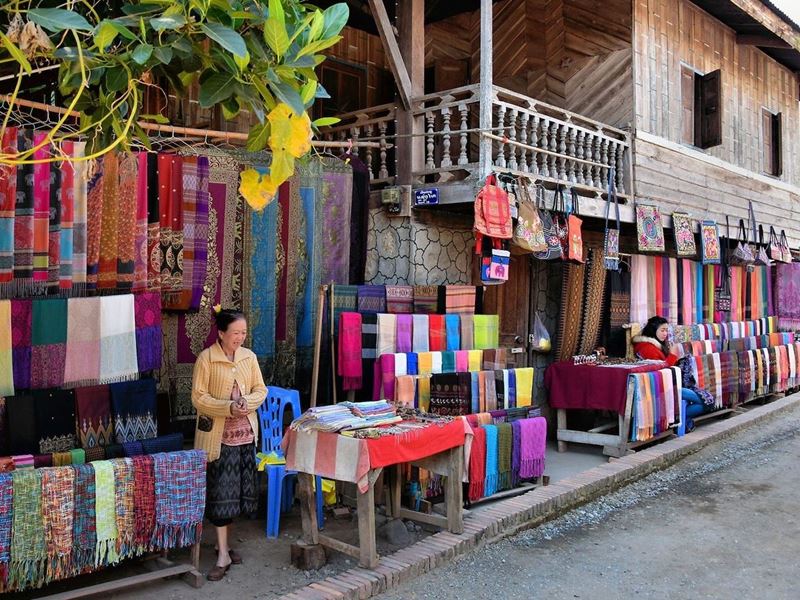
Ban Xang Hai Village
<p style="text-align: justify;"> A visit to <strong>Ban Xang Hai</strong> (the Whiskey village) is essential in a <strong>circuit in Laos</strong> if you want to savor excellent homemade alcohol. </p> <p style="text-align: justify;">In accordance with its name, this village is well - known for wines, especially "Lao Lao". It is a traditional Laos whiskey made of rice. Besides, there are snake, spider, other creepy - crawly wines that are sold in bottles or in jars.</p> <p style="text-align: justify;">Ban Xang Hai is located near the <strong>Mekong River</strong>. It is a unique place in Luang Prabang. As this village is right on the road to Pak Ou caves, this allows you to visit it before entering the caves.</p> <p style="text-align: justify;">Otherwise, there are three attractions in all in the village: silk weaving, production of whiskey and of Sa paper. It may be said that Laotian hand woven silks are much liked and appreciated by tourists. It takes about 4 weeks to produce the whiskey, to look at how to do it with your own eyes and buy this alcoholic creation, is special. If you prefer to the weaving of Laotian silk, you can buy them or Sa paper products, all manufactured locally.</p> <p style="text-align: justify;">You would be surprised that there are beautiful temples, shrines, and relics decorated here. All this has drawn an interesting central district that we cannot find anywhere else in Laos. You also might meet the monks who live here. While opening the local school, children will rush out who are very cute and always fascinated by foreign visitors. There are some small local restaurants where the food is quite delicious and cheap.</p> <p style="text-align: justify;">The people in this Whiskey village are really friendly and hospitable. You would be warmly welcomed there’re for sure. After a tiring journey, you can relax in a pontoon boat to contemplate the sunset towards the banks of the Mekong River by the flow of water.</p> <p style="text-align: justify;"> </p>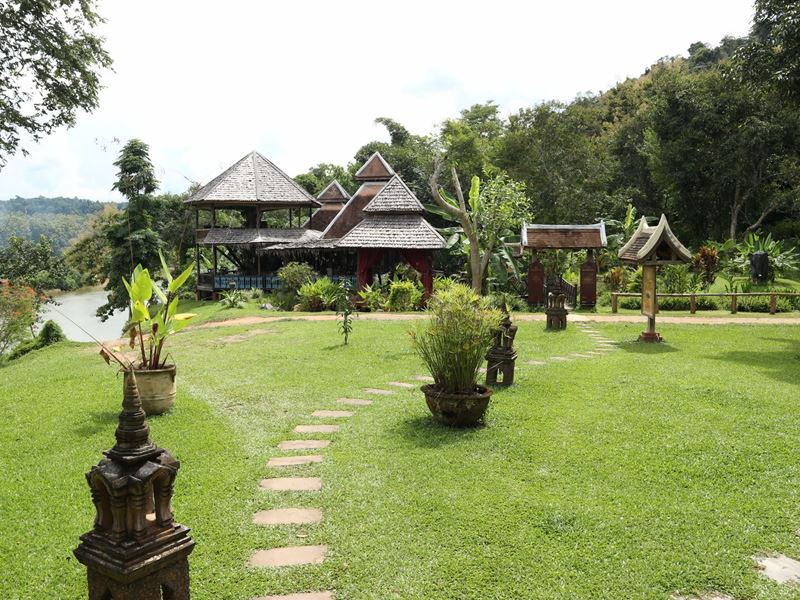
Elephant Village
<p style="text-align: justify;">It is certain that some of you have the dream of riding on a large animal once in life. So, we offer you an <strong>elephant village sanctuary</strong> tour in Luang Prabang during your travel in Laos.</p> <p style="text-align: justify;">This village was found in October 2003. Initially, it was just a small camp that rented two elephants from the nearby Hongsa neighborhood. Afterwards, the camp began to purchase its own elephants.</p> <p style="text-align: justify;">Located in the Xieng Lom village, very close to the banks of the Nam Khan River and about 16km from Luang Prabang in the South East, the Elephant Village Sanctuary (or Elephant Park) founded for the purpose of saving elephants from abuse and then caring and protecting them.</p> <p style="text-align: justify;">So they have recently removed bulky armchairs from the back of elephants. Instead, you can climb directly onto its backs.</p> <p style="text-align: justify;">The elephant in Laos is used by man for working, logging. These elephants are often forced to work hard. That's why local people brought these poor animals to a house in the forest where they can rest and be cared for. Some wounded elephants would have a chance of recovery with a veterinarian on-site.</p> <p style="text-align: justify;">In this village, elephants can walk freely and are trained by the mahouts (guide and elephant trainer) who will ride on his back.</p> <p style="text-align: justify;">This village would offer you a unique experience in life to live closely to the animal and nature since you could give a bath and food to the elephants, take an elephant ride or a mahout experience. It means you would be given elephant training courses between half a day and two days.</p> <p style="text-align: justify;">After these courses, if you wish to take a bath with your elephant in the Nam Khan River, it is possible to take additional courses.</p> <p style="text-align: justify;">As this sanctuary village is individual and is not supported by any organization. Then your visit will help lengthen its running time and bring happiness to the elephants.</p>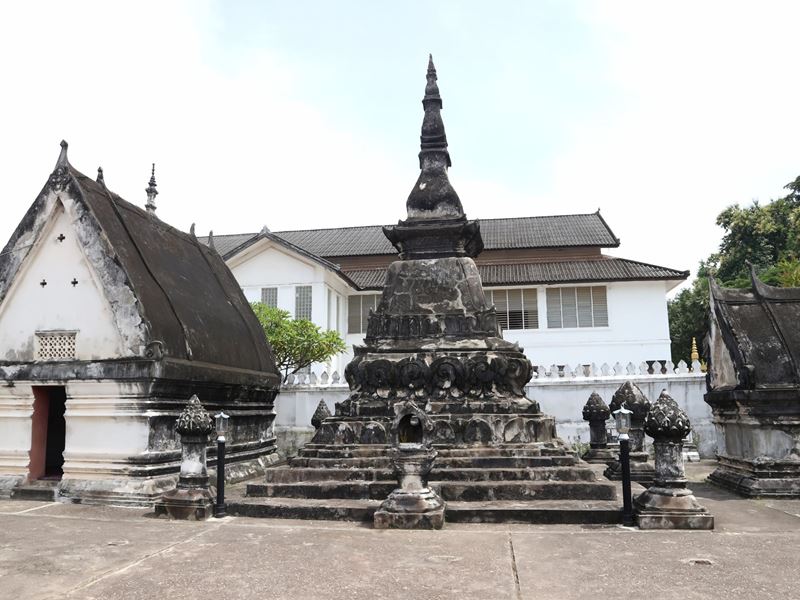
Wat Mai Temple
<p style="text-align: justify;"><strong>Wat Mai Temple</strong> (Wat Mai Suwannaphumaham) is in the group of the largest and most charming <strong>temples of Luang Prabang</strong>. This is why this temple is very important in the Laotian life, especially during the New Year (Boun Pi Mai). Meanwhile, the Laotians of all regions celebrate the three days holiday by watering deferentially Buddha statues and praying.</p> <p style="text-align: justify;">Founded in 1780 by King Anurat, Wat Mai means "the New Temple" in Laotian, located just 1 km from the city center and near the Royal Palace Museum. This temple is also known as one among a very small minority of the temples that survived the demolition of the Chinese invaders in 1887 and as a place where the royal family often used, and Pra Sangkharat- the highest dignitary of Laotian Buddhism resided.</p> <p style="text-align: justify;">From the outside, Wat Mai is very large, lies on a vast ground. It features a style of religious architecture, consists of an ordination hall (sim) and some koutis (dwelling of the monks). A veranda was added in front and the back of the ordination hall in 1821. In the following decades, many other monuments were added. The triangular, pointed 4 - tiered roof of the ‘sim’ extends almost to the ground with gilded Nagas snakes on all its corners. The large solid pillars are all gilded and meticulously carved.</p> <p style="text-align: justify;">Inside, there is a large Buddha statue located in the middle of the main room, on its two sides are two lines of other smaller statues sitting or standing. In addition, the walls are decorated by at least thousands of very small golden statues and figurines. But among them, the seating statue of emerald stone is the most important of the temple. Wat Mai has already preserved the most precious statue of Luang Prabang – the Prabang, which is now in the Royal Palace Museum. Each year, during the New Year (Boun Pi Mai), residents move the Prabang to Wat Mai to wash and expose it outside.</p> <p style="text-align: justify;">Wat Mai is open every day between 8am and 5pm. There is nothing more wonderful than reaching Wat Mai on a cycling tour and we as an experienced travel agency will be your loyal companion.</p> <p style="text-align: justify;"> </p>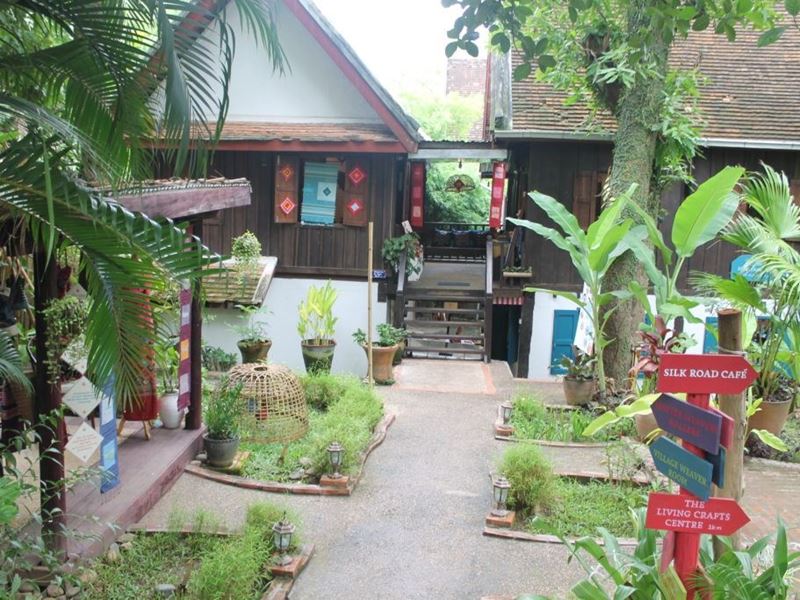
Ock Pop Tok
<p style="text-align: justify;">We offer you a discovery of the <strong>Silk Weaving Center (Ock Pop Tok)</strong> in your tour in Laos since this place keeps its weaving tradition very well and can absolutely interest you.</p> <p style="text-align: justify;">This center is next to the Mekong riverside, just 2km in Tuk Tuk towards the south of Luang Prabang. Established in 2002 by a Laotian woman, Veomanee Douangdala and an English woman Joanna Smith for the purpose of protecting the Laotian tradition. Ock Pop Tok was initially a small shop selling only certain models.</p> <p style="text-align: justify;">To this day, it has become one of the most important textile centers in Laos and Southeast Asia. Ock Pop Tok means in Laotian "East meets West" offering weaving courses from one day to three days to teach young artists. This helps them to upgrade their technical skills and improve the quality of life. It is therefore possible to participate if you want.</p> <p style="text-align: justify;">Ock Pop Tok provides high quality and reasonably priced silk handicraft products, for example: scarves, bags, and pillows. In particular, the Ikat scarf is quite well known for its beauty. It makes use of the H’mong people's figured material.</p> <p style="text-align: justify;">Some traditional weaving products in association with the technique of Laotian and Thai artists are rather loved. They can be chosen as a dowry in traditional marriage in Laos.</p> <p style="text-align: justify;">Working conditions are perfect. Employees are paid about 4 times higher than the average salary in Laos. That is why they are so strongly attached to this career.</p> <p style="text-align: justify;">While visiting this center, you will learn a lot about the manufacturing process of Laotian textile products. There are also restaurants, coffee shop, villas out there for tourists.</p> <p style="text-align: justify;"> </p>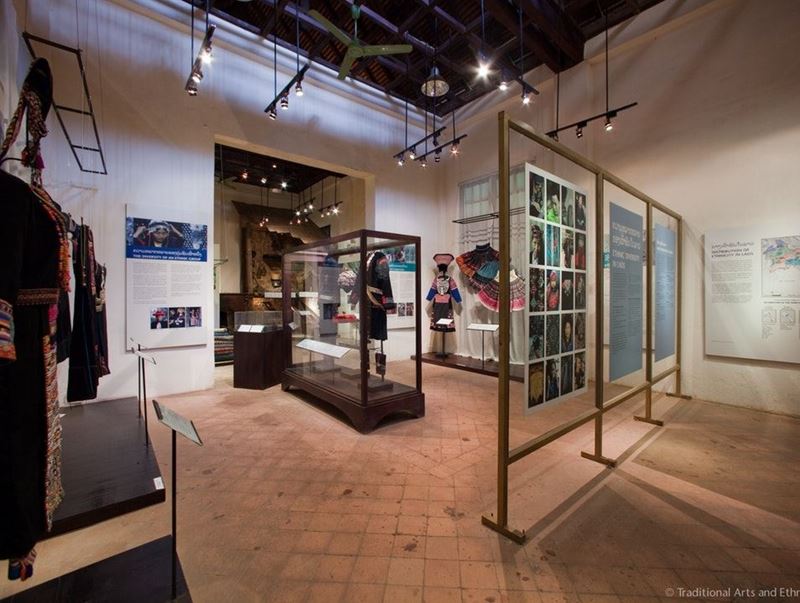
The Traditional Arts and Ethnology Centre
<p style="text-align: justify;">Visiting <strong>The Traditional Arts and Ethnology Centre</strong> (TAEC) would make your tour in Luang Prabang more interesting because of its good preservation of the Laotian's valuable cultures.</p> <p style="text-align: justify;">This center was established by Thongkhoun Soutthivilay and Tara Gujadhur in July 2007 at the foot of Mount Phousi, very close to the animated Luang Prabang city.</p> <p style="text-align: justify;">It receives annually a large number of tourists. To this day, more than 50,000 foreign visitors and 7,000 Laotians have discovered with pleasure this small museum which is now protected by UNESCO in a historic building.</p> <p style="text-align: justify;">Moreover, this place was recognized by the Department of Culture and Information, the Lao national tourism Authority.It has become a non-profit museum dedicated to the culture of the different ethnic groups of Laos.</p> <p style="text-align: justify;">There are many permanent exhibitions, such as traditional costumes, textiles, photographs, jewellery, baskets, religious artefacts, artisanal tools, etc.Although the center is a bit small, it is packed with very interesting rooms and well arranged according to an international standard.</p> <p style="text-align: justify;">Here you can find the collection with about 400 objects and 30 ethnic groups in northern Laos. Some come from private collections.There are instructions in English, Laotian, French or even Chinese, Portuguese, German, ...</p> <p style="text-align: justify;">In addition, the center often exhibits temporary exhibitions. The subject of the first exhibition was " Splendour and Sacrifice: Taoism of Northern Laos", which took place in 2009.</p> <p style="text-align: justify;">There are 4 main ethnic groups which permanent exhibition revolves around. They are the <strong>Khmu, the Hmong, the Akha, the Tai Lue</strong>. Otherwise, the museum has a library of CDs, DVDs, magazines, books and photos about Laos and Asia.</p> <p style="text-align: justify;">His souvenir shop sells handicrafts made by villagers. If you want to rest, it is possible to go to the Patio Coffee for tea, coffee or traditional ethnic minority food.</p> <p style="text-align: justify;">The opening hours are between 9 am and 6 pm every day except Mondays. The fare is 20000 LAK (about US $ 2.5).</p> <p style="text-align: justify;"> </p>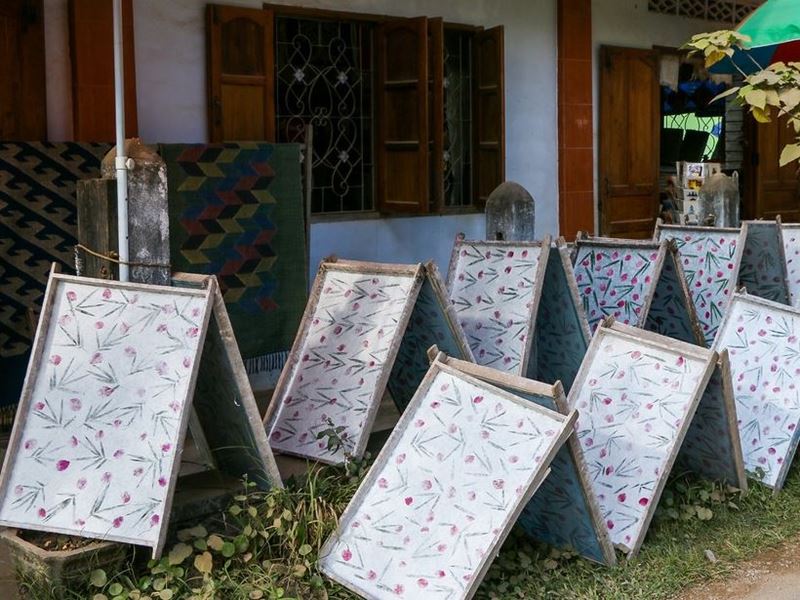
Ban Xang Khong Village
<p>You cannot miss having "<strong>Ban Xang Khong</strong>" on the list of places to visit during your trip to Laos. Xang Khong is a charming village located 5km east from the heart of Luang Prabang city and on the banks of the Mekong River, close to the <strong>Pak Ou caves</strong>. It is very famous for its traditional Sa paper making. </p> <p>The Sa is a kind of specific and unique paper in Laos. It is made of fresh flowers, leaves and bark of the mulberry tree. After 15 minutes of treatment, the fresh flower paintings will be dried. Then they are used as a material to produce lanterns, photo frames, postcards, book covers or bags for sale to tourists.</p> <p>This type of paper can keep the natural color of the flowers and leaves for about 3 years without using any chemicals. Sa paper has hundreds of years of history in Laos and is a widespread article in the artisan shops in Laos.</p> <p>To this day local people still use simple and rudimental tools while making paper. Most of them live by weaving and displaying silk scarves for sale in the Luang Prabang night market . If you want it is possible to participate in a design of the cotton or silk scarf. </p> <p>Sa paper is also known in Thailand, but 80 percent of the mulberry bark for making paper in Thailand comes from Laos. The three provinces of Laos: Luang Prabang, Oudomxay and Xayaburi are the largest suppliers.</p> <p>In conclusion, we could say that this village is worth a visit, not only thanks to its famous trade, but also to the warm villagers. Indeed, you could be invited to their home, to taste their local alcohols and their other specialties as a guest. But it should be noted that their beverages are quite strong.</p> <p> </p>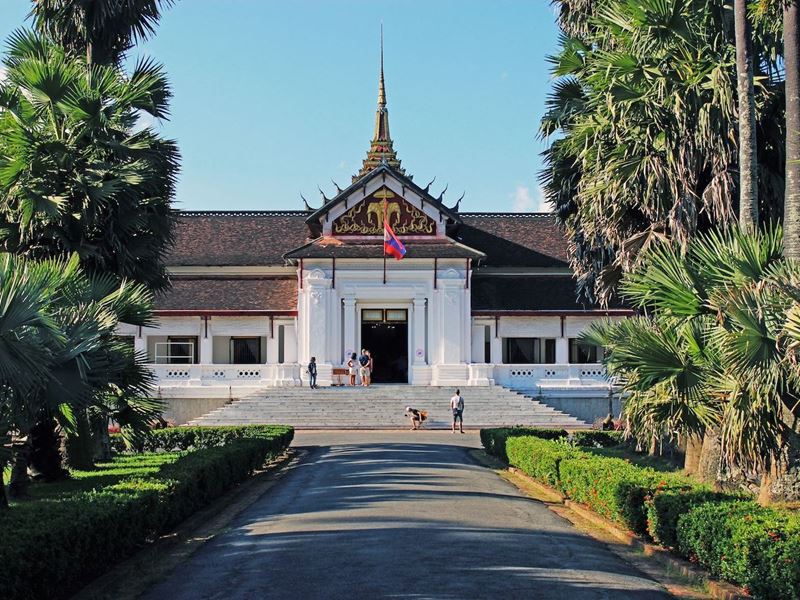
The Royal Palace Museum
<p style="text-align: justify;">When coming to Luang Prabang a visit to the <strong>Royal Palace Museum</strong> (Haw Kham or Golden Hall) is a must. The building was erected between 1904 and 1909, during the French Protectorate of Laos time. Situated in the heart of the city the Haw Kham, (Golden Hall), is an ideal place to study or learn some history and royal lifestyle of Laos. The architecture of the building is a mixture of French Beaux –Art style and traditional Laos style, making it not only old, but also contemporary. Outside the entrance, whose marble steps were imported from Italy, there are two rows of very high borassus. The museum has many objects of interest, of both religious and royal origins. Its ceiling and many exhibits are gilded.</p> <p style="text-align: justify;">The museum is open daily from 8am to 12pm and from 2pm until 5pm every day. The museum is very important to Loatians, to preserve both their historical and cultural heritage. Tourists should walk and speak quietly when visiting the museum. The most precious item in the museum is the Prabang statue (standing Buddha) weighing 48kgs and standing 83cm tall, made from an alloy of gold, silver and bronze.</p> <p style="text-align: justify;">When leaving the museum you can climb nearby Mt Phousi to see the beautiful panorama of Luang Prabang.</p>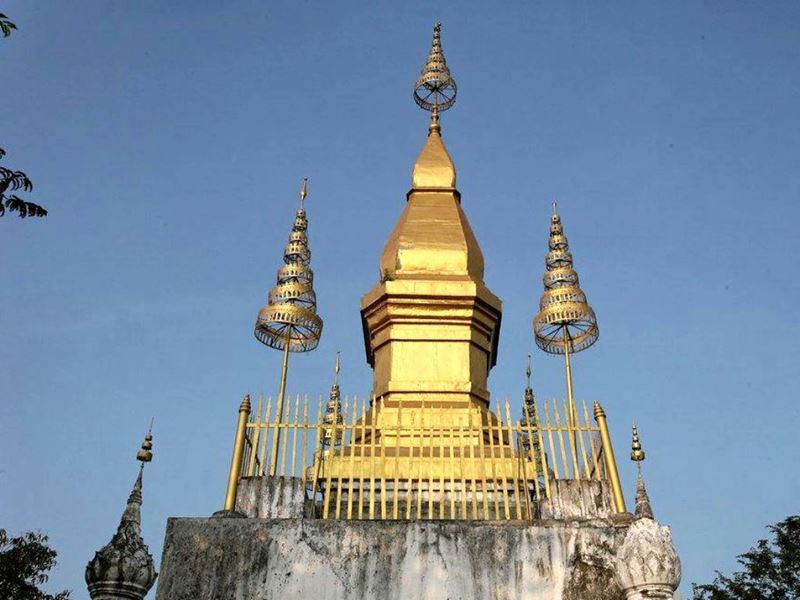
The Mount Phousi
<p style="text-align: justify;">Laotians often say: “If you do not arrive at <strong>Mount Phousi</strong>, you do not yet arrive in Luang Prabang”.</p> <p style="text-align: justify;">Mount Phousi means “Mount Luminous”, which is actually a small hill located right in the city centre, in front of the Royal Palace and next to Sisavang Vong. The “mountain” is 1000mts long, 250mts wide and 80mts high. From the floor of the mountain one must cross over 300 brick steps, there are places to make stops along the climb; and at one you can see a snowbell that was offered to Laos in the year 2500 of the Buddhist era, by the Indian Government. As Mt Phousi is the highest elevation in Luang Prabang it is an ideal place to get an overview of the township, especially at sunset or early in the morning at sunrise when the view is really beautiful. On the climb you will see hundreds of frangipani (Champa flowers) whose fragrant flowers give the mountain a lovely smell. On its peak there is a small yellow tower named Chom Si, and beside it is a room with a Buddha statue, for practicing Buddhism, that weighs 50 kgms.</p>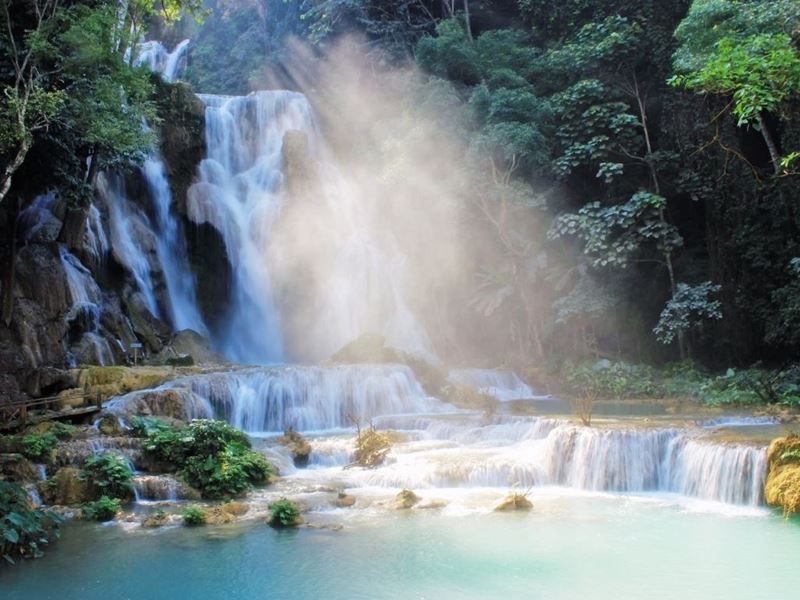
Kuang Si Waterfalls
<p style="text-align: justify;">Most visitors who arrive at Kuang Si waterfalls, want to stay forever because they are the most beautiful falls in the ancient Luang Prabang vicinity.</p> <p style="text-align: justify;">Situated approximately 30kms south of the city centre, and surrounded by thick forests, the road to the falls is quite smooth and asphalted although somewhat winding. There are several falls in the area that is being developed into a large public park. Tourists may arrive at the falls by bus or Tuk-tuk (a motorized tricycle). As you travel along the road to the falls you notice the abundance of wildflowers, and after visiting the falls and swimming (if desired), there are also some rather pretty cultural villages to see. The water at the Kuang Si Waterfalls are a lovely see through blue colour, because of the algae, and can be visited all year round as if it is raining , there is more water to play in!. Travelers can trek through the surrounding forests if you want, or climb on the waterfalls, the scenery is really nice.</p> <p style="text-align: justify;">The atmosphere in this park area of Kuang Si is fantastic, as the sound of the waterfalls mixes with bird noises and creates a wonderful piece of music to help you relax !</p>